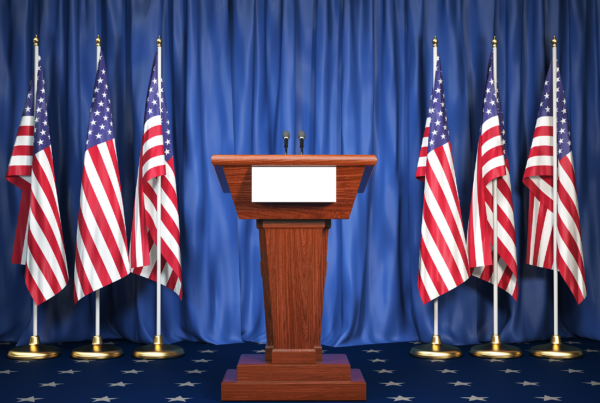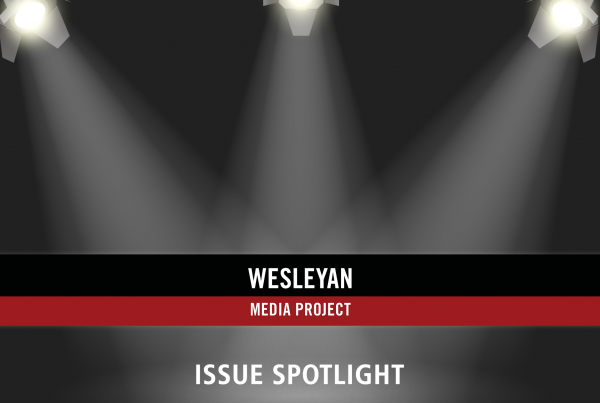Super PACs Sponsor Bulk of Presidential Ads;
Obama, Crossroads GPS Battle in Same States
(MIDDLETOWN, CT) May 2, 2012 – The 2012 presidential race is shaping up to be an overwhelmingly negative one, much more negative than the 2008 contest to date. As Table 1 shows, 7 out of 10 of the ads aired in this year’s presidential contests have been negative—that is, they mentioned an opponent. This compares to fewer than 1 in 10 ads aired during the 2008 presidential race up to this point that were negative.
Table 1: Tone of Ads in Presidential Race (2008 and 2012)*
| 2008 | Negative | Positive |
|---|---|---|
| Candidate | 8.6% | 91.4% |
| Interest Group | 25.2% | 74.8% |
| Party | - | - |
| Total | 9.1% | 90.9% |
| 2012 | Negative | Positive |
| Candidate | 52.5% | 47.5% |
| Interest Group | 86% | 14% |
| Party | 2.2% | 97.85% |
| Total | 70% | 30% |
| *Totals are from 1/1/2007 through 4/22/2008 and from 1/1/2011 through 4/22/2012. Numbers include all presidential advertising on broadcast television and national cable. CITE SOURCE OF DATA AS: Kantar Media/CMAG with analysis by the Wesleyan Media Project. |
||
“One reason the campaign has been so negative is the skyrocketing involvement of interest groups, who have increased their activity by 1100 percent over four years ago” said Erika Franklin Fowler, co-director of the Wesleyan Media Project. “But we cannot attribute the negativity solely to outside groups. Even the candidates’ own campaigns have taken a dramatic negative turn.”
Interest group airings, though few in 2008, were overwhelmingly positive (75 percent) in that year compared to only 14 percent positive this year. Candidate airings, which made up the bulk of the airings in 2008, were only 9 percent negative in 2008. So far in this election cycle more than half of the ads sponsored by candidates (53 percent) have been negative.
Table 2 shows that the total number of presidential ads (through April 22) was just over 200,000 airings on broadcast television and national cable. Candidate-sponsored ads, which made up 96.6 percent of the total airings in 2008, declined to just over a third (35.8 percent) of the total this year. Making up for most of the difference are outside groups (including Super PACs) who have sponsored almost 60 percent of the ads aired this year, compared to just 3 percent of ad airings in 2008. An estimated $112M has been spent to date on 207,000 ads compared to $190M spent on just under 300,000 ads in 2008. Much of this decline in spending and ad volume is due to the lack of a nomination contest on the Democratic side this year.
“Such levels of outside group involvement in a presidential primary campaign are unprecedented,” said Travis Ridout, co-director of the Wesleyan Media Project. “This is truly historic. To see 60 percent of all ads in the race to-date sponsored by non-candidates is eye-popping,” he added.
Table 2: Advertising in 2012 Presidential Race*
| Year | Candidate | Interest Group | Party | Total | |
|---|---|---|---|---|---|
| 2008 | Ads Aired | 289,622 | 10,062 | 0 | 299,684 |
| Row % | 96.64% | 3.36% | 0.00% | 100.00% | |
| Est. Cost | $183.4M | $6.3M | $0 | $189.6M | |
| 2012 | Ads Aired | 74,267 | 123,062 | 9,897 | 207,226 |
| Row % | 35.80% | 59.40% | 4.80% | 100.00% | |
| Est. Cost | $28.1M | $77.5M | $6.1M | $111.7M | |
| % volume increase | -74.36% | 1123.04% | -30.85% | ||
| % spending increase | -84.68% | 1139.12% | -41.09% | ||
| *Totals are from 1/1/11 through 4/22/12. Amounts include all presidential advertising on broadcast television and national cable. CITE SOURCE OF DATA AS: Kantar Media/CMAG with analysis by the Wesleyan Media Project. |
|||||
Table 3 displays the top sponsors of general election advertising spots. Crossroads GPS has aired nearly 17,000 (mostly anti-Obama) spots. This compared to 10,500 spots from the Obama campaign and 9,842 spots from the Democratic National Committee. Americans for Prosperity, another Republican group, has aired over 7,000 ads. General election advertising so far has favored the GOP at a ratio of 1.31:1, with 33,420 anti-Obama, pro-Republican spots aired compared to 25,516 anti-Republican, pro-Obama spots aired.
Table 3: Top General Election Ad Spenders
| Group | Ad Airings | Est. Spending | Party or Party Favored | Markets Airing |
|---|---|---|---|---|
| Crossroads GPS | 16,747 | $12.6M | GOP | 47 |
| Barack Obama | 10,570 | $3.5M | Dem | 36 |
| Democratic National Committee | 9,842 | $6.1M | Dem | 22 |
| Americans for Prosperity | 7,115 | $6.9M | GOP | 0 |
| American Energy Alliance | 4,771 | $3.3M | GOP | 26 |
| American Future Fund | 2,838 | $2.9M | GOP | 21 |
| Priorities USA Action | 2,447 | $1.3M | Dem | 22 |
| Environmental Defense | 1,606 | $1.1M | Dem | 0 |
| American Petroleum Institute | 1,493 | $1.7M | GOP | 15 |
| AFSCME | 1,051 | $1.2M | Dem | 7 |
| American Crossroads | 401 | $0.2M | GOP | 9 |
| Republican National Committee | 55 | $0.02M | GOP | 17 |
| Totals are from 1/1/11 to 4/22/12. Amounts include broadcast television and national cable spots. CITE SOURCE OF DATA AS: Kantar Media/CMAG with analysis by the Wesleyan Media Project. |
||||
“The biggest difference between general and primary election ads so far is that the majority of general election airings and spending has come from groups that do not need to disclose their donors,” said Michael M. Franz, co-director of the Wesleyan Media Project. “That’s a lot of money and airtime backed by undisclosed sources.”
Candidates have relied heavily on Super PACs to air ads on their behalf during the 2012 presidential campaign. Wesleyan Media Project analysis (Table 4) reveals that several candidates relied upon their Super PACs to pay for a majority of their advertising, including Jon Huntsman, Newt Gingrich, Rick Santorum and Mitt Romney. Ron Paul was least reliant on Super PAC advertising of all the major candidates. About 20 percent of Obama’s advertising has been sponsored by his Super PAC, though the Democratic National Committee has also aired a substantial number of ads on his behalf.
Table 4: Super PAC Sponsorship of Advertising
| Candidate | SuperPAC | % SuperPAC | |
|---|---|---|---|
| Huntsman | 68 | 811 | 92.3% |
| Gingrich | 6,373 | 11,558 | 64.5% |
| Santorum | 6,330 | 11,471 | 64.4% |
| Romney | 30,135 | 496 | 62.20% |
| Perry | 11,979 | 6,465 | 35.1% |
| Obama | 10,570 | 2,447 | 18.8% |
| Paul | 7,860 | 755 | 8.8% |
| Totals are from 1/1/11 to 4/22/12. Amounts include broadcast television and national cable spots. CITE SOURCE OF DATA AS: Kantar Media/CMAG with analysis by the Wesleyan Media Project |
|||
Recent Presidential Activity
Since Santorum dropped out of the race on April 10, Romney and his Super PAC continued to focus on the primary race, blanketing Pennsylvania with 2,076 spots from April 11 to April 22.
The Obama campaign and Priorities USA Action (Obama’s Super PAC) have been going toe-to-toe with Crossroads GPS across markets in Iowa, North Carolina, Ohio, Colorado, Florida, Virginia, and Nevada, as Table 5 shows. All but four of the markets in Table 5 feature ads from both pro-Obama and pro-Romney forces, meaning voters in these markets are already experiencing the back and forth of the general election.
“Early general election spending reveals that both parties are focused on markets in the same key battleground states,” notes Travis N. Ridout, co-director of the Wesleyan Media Project. “The past couple of weeks, Obama and his Super PAC have been on the air in a few more markets than Crossroads GPS, but both sides have focused their advertising in markets in Nevada, Colorado, Florida, Virginia, Iowa, and Ohio.”
Table 5: Number of Ads Aired by Sponsor and Market (April 11-22, 2012)
| Obama | Priorities USA Action | Crossroads GPS | |||||
|---|---|---|---|---|---|---|---|
| Las Vegas | 190 | Tampa | 143 | Las Vegas | 300 | ||
| Grand Junction | 173 | Ft. Myers | 97 | Cleveland | 289 | ||
| Orlando | 163 | Toledo | 89 | Tampa | 281 | ||
| Cleveland | 155 | Orlando | 1 | Ft. Myers | 3 | ||
| Charlottesville | 132 | Cleveland | 84 | Charlottesville | 231 | ||
| Colorado Springs | 121 | West Palm Beach | 82 | Orlando | 224 | ||
| Reno | 114 | Charlottesville | 73 | Columbus, Ohio | 199 | ||
| Tampa | 113 | Columbus, Ohio | 70 | West Palm Beach | 184 | ||
| Ft. Myers | 104 | Richmond | 1 | Colorado Springs | 2 | ||
| Richmond | 103 | Des Moines | 59 | Reno | 183 | ||
| Toledo | 95 | Cedar Rapids | 57 | Richmond | 167 | ||
| Des Moines | 86 | Grand Junction | 163 | ||||
| West Palm Beach | 86 | Toledo | 156 | ||||
| Columbus, Ohio | 85 | Cedar Rapids | 136 | ||||
| Lima | 80 | Lima | 121 | ||||
| Cedar Rapids | 78 | Des Moines | 120 | ||||
| Norfolk | 31 | ||||||
| Denver | 30 | ||||||
| Roanoke | 28 | ||||||
| Dayton | 18 | ||||||
| Amounts include broadcast television. CITE SOURCE OF DATA AS: Kantar Media/CMAG with analysis by the Wesleyan Media Project. |
|||||||
Independent groups have been active not just in the presidential campaign. Since April 1, numerous outside groups have aired ads on behalf of a variety of candidates, as Table 6 shows (only groups with more than 250 airings are reported). For instance, the Club for Growth has been airing ads in the Republican Senate primaries in Indiana and Nebraska, Americans for Prosperity has been involved in the Nebraska Senate race, and the American Action Network has weighed in on Senate contests in Florida and Indiana.
Table 6: Activity of Independent Groups
| Group | Ad Airings | Races Active |
|---|---|---|
| American Energy Alliance | 4,028 | President |
| Crossroads GPS | 3,202 | President |
| Restore Our Future, Inc. | 2,135 | President |
| Environmental Defense | 1,608 | President |
| Club For Growth | 1,486 | Indiana and Nebraska Senate |
| Right Direction Wisconsin PAC | 1,411 | Wisconsin Governor |
| Priorities USA Action | 908 | President |
| Americans For Prosperity | 710 | Nebraska Senate |
| American Action Network | 610 | Florida and Indiana Senate |
| League of Conservation Voters | 592 | Ohio Senate, PA17 |
| Citizens For Strength And Security | 478 | Montana Senate |
| Red, White, And Blue Fund | 442 | President |
| America Works USA | 387 | Missouri Governor |
| Patriot Majority USA | 336 | Missouri Senate, GA12 |
| Constitution Trust | 266 | NC Lieutenant governor |
| Campaign For Primary Accountability | 252 | PA17, PA18 |
| Totals are from 4/1/12 to 4/22/12, and only for groups who aired a minimum of 250 ads. Amounts include broadcast television and national cable spots. CITE SOURCE OF DATA AS: Kantar Media/CMAG with analysis by the Wesleyan Media Project. |
||
Wisconsin Governor Recall
Although the presidential race has received the majority of attention this year, there are some other highly competitive races around the country. One that has seen a lot of advertising, in particular, is the recall race of the Wisconsin governor, Scott Walker. Over 17,000 spots at an estimated cost of $6M have flooded the state. Table 7 shows that Walker and his ally, Right Direction Wisconsin PAC (an arm of the Republican Governor’s Association) have aired considerably more advertisements than his Democratic opponents. Combined, the pro-Walker advertisers have aired over 10,000 ads. That compares to fewer than 5,000 ads combined from Democratic candidate Kathleen Falk and an outside group, Wisconsin for Falk, working on her behalf. Democrat Tom Barrett has aired more than 1,700 ads.
“Wisconsinites have been inundated with advertising surrounding the gubernatorial recall election,” said Mike Franz, co-director of the Wesleyan Media Project. “Walker and his allies hold a substantial advantage to date in the air war in all markets except Madison, and the incumbent governor’s ads have been more positive than his competitors’ ads.”
Table 7: Advertising in Wisconsin Governor Recall
| Sponsor | Ad Airings | Est. Spending |
|---|---|---|
| Tom Barrett | 1,731 | $0.47M |
| Kathleen Falk | 742 | $0.17M |
| Wisconsin for Falk | 4,180 | $1.8M |
| Greater Wisconsin Political Fund | 549 | $0.15M |
| Doug LaFollette | 70 | $0.01M |
| Hari Trivedi | 9 | $0.06M |
| Right Direction Wisconsin PAC | 3,483 | $1.3M |
| Scott Walker | 6,553 | $2.0M |
| Totals are from 1/1/2012 through 5/1/2012. Amounts include broadcast television. CITE SOURCE OF DATA AS: Kantar Media/CMAG with analysis by the Wesleyan Media Project. |
||
About This Report
Data reported here do not cover local cable buys, only broadcast television and national cable buys. All cost estimates are precisely that: estimates.
The Wesleyan Media Project provides real-time tracking and analysis of all political television advertising in real-time. Housed in Wesleyan’s Quantitative Analysis Center – part of the Allbritton Center for the Study of Public Life – the Wesleyan Media Project is the successor to the Wisconsin Advertising Project, which disbanded in 2009. It is directed by Erika Franklin Fowler, assistant professor of government at Wesleyan University, Michael M. Franz, associate professor of government at Bowdoin College and Travis N. Ridout, associate professor of political science at Washington State University.
The Wesleyan Media Project is supported by grants from The John S. and James L. Knight Foundation, the Rockefeller Brothers Fund, and Wesleyan University. Data provided by Kantar Media/CMAG with analysis by the Wesleyan Media Project using Academiclip, a web-based coding tool.
Periodic releases of data will be posted on the project’s website and dispersed via Twitter @wesmediaproject. To be added to our email update list, click here.
For more information contact:
Lauren Rubenstein, lrubenstein@wesleyan.edu, (860) 685-3813
Wesleyan University, in Middletown, Conn., is known for the excellence of its academic and co-curricular programs. More than 2,700 undergraduates and over 200 graduate students from around the world pursue their classroom studies, research projects, and co-curricular interests in ways that are demanding and intensely rewarding.
The John S. and James L. Knight Foundation supports transformational ideas that promote quality journalism, advance media innovation, engage communities and foster the arts. We believe that democracy thrives when people and communities are informed and engaged. For more, visit www.knightfoundation.org.
The Rockefeller Brothers Fund advances social change that contributes to a more just, sustainable, and peaceful world. The Fund’s grantmaking is organized in three thematic programs that support work in the United States and at the global level: Democratic Practice, Sustainable Development, and Peacebuilding; and in three pivotal place programs that address these themes in specific contexts: New York City, Southern China, and the Western Balkans. For more, visit www.rbf.org.
###



